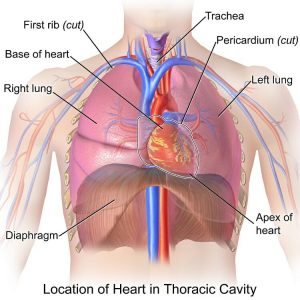Thoracic Cavity Definition
The thoracic cavity, also called the chest cavity, is a cavity of vertebrates bounded by the rib cage on the sides and top, and the diaphragm on the bottom. The chest cavity is bound by the thoracic vertebrae, which connect to the ribs that surround the cavity. The thoracic cavity is actually composed of three spaces each lined with mesothelium, a special film-like tissue that separates vital organs. The pleural cavities surround the lungs, while the pericardial cavity surrounds and protects the heart. These tissues in the thoracic cavity can be seen in the image below.
The thoracic cavity has two openings, one from the top leading to the mouth and throat, and the other allowing the esophagus and other important vessels and tissues to pass between the thoracic cavity and the abdominal cavity. The thoracic inlet allows the esophagus and trachea to penetrate the thoracic cavity. The esophagus will pass all the way through the cavity to connect with the stomach, while the trachea lead to the bronchi of each lung which lead to smaller and smaller passages that fill the lungs. Nerves, blood vessels, and lymph vessels pass through the thoracic inlet to carry material to and from the head and mouth. The thoracic outlet is the opening on the posterior side of the cavity, which leads to the gut. Again, nerves and vessels traverse this outlet to leave the thoracic cavity.
Function of Thoracic Cavity
The thoracic cavity has several functions. The first is to provide protection and support to the body’s vital organs. The thoracic cavity is surrounded by the rib cage and several layers of membranes, which help keep the organs protected from any dangers in the environment. The heart must be kept in a relatively safe and stable position if it is to continue beating and providing pressure to the body’s vessels. In addition to providing support, the rib cage functions in unison with the diaphragm and other muscles to draw air in and out of the lungs. If any of the cavities surrounding these vital organs get punctured, the resulting pressure can cause the lungs to collapse or pressure to be exerted on the heart, which can cause a heart attack.
Thoracic Cavity Organs
The thoracic cavity contains the heart, and many of the main vessels of the circulatory system. The heart is contained within the pericardial cavity, which is separated from the other cavities of the thoracic cavity. The lungs are also contained within their own cavities, the pleural cavities, and connect to the mouth through the trachea and the thoracic inlet. Besides these major vital organs, the thoracic cavity is home to many nerves and vessels. Some run straight through the chest cavity, while others serve nerves and muscles in the cavity which help regulate breathing, the rhythm of the hearth, and the function of various muscles. Other minor organs include endocrine glands, lymph ducts, and the esophagus, which simply passes through the thoracic cavity. The arrangement of these organs can be seen in the image below.
Related Biology Terms
- Abdominal Cavity – The cavity that lies posterior to the thoracic cavity, and hold much of the digestive system.
- Coelom – The cavity, or cavities formed during development that eventually become the thoracic and abdominal cavities.
Quiz
1. An earthworm has defined body cavities, some of which contain the worm’s heart. Does the worm have a thoracic cavity?
A. No, thoracic cavities are specific to vertebrates
B. Yes, the thoracic cavity surround the heart
C. Yes, it’s just different
2. A doctor receives a patient in the Emergency Room. The patient has been stabbed in the back by an assailant. The patient is having trouble breathing. The doctor stabs the patient in the back again, with a needle connected to an open tube. Why did the doctor do this?
A. The doctor is obviously crazy.
B. The medicine for a knife wound is administered in this fashion.
C. The doctor is trying to drain the fluid in the pleural cavity, which is causing a collapsed lung.
3. While a fish also protects its heart in the thoracic cavity, fish use gills rather than lungs to breath. The lungs are located on the outside of the thoracic cavity. How does this change the function of the cavity?
A. It does not need to expand and contract.
B. It is no longer used to protect the heart.
C. The cavity no longer carries blood and lymph vessels.


